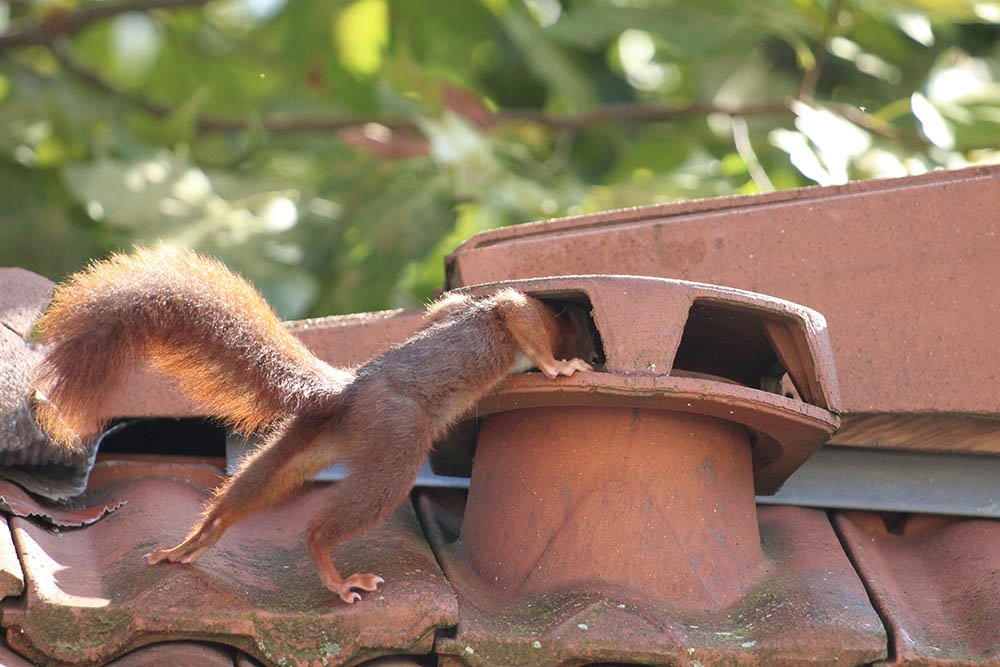Squirrel Removal in Manchester, CT
860-236-2683
As a homeowner or business owner, the last thing you want is to have a wild animal invading your home. The most common pests that you will encounter in your home, especially in the New England area, are squirrels. The squirrels that can enter your home range from all different sorts such as grey, red or even flying squirrels. Squirrels are smart and can squeeze into even the tiniest of gaps or holes that may be around your property. Once a squirrel has made its way into your home they cause a lot of damage. This article discusses how to keep squirrels out of your house and to prevent them from getting in again.
How to Keep Squirrels Out of Your Home
There are many variables involved to keep squirrels out of your structure. If you are not sure of what you are doing it may be best to consult with a professional.
In order to keep squirrels out of your house, start by thoroughly examining the exterior of your home. Pay close attention to the eaves for holes and cracks, then start to fill or cover any gaps you find with a hard material such as fiber cement, sheet metal flashing, or auto body filler. Check gable, soffit, and power vents in the attic – as well as caps on chimneys – to make sure they have metal hardware cloth behind them that’s firmly attached around the edges.
*Note: Keep in mind that no repellent is wholly effective to a determined squirrel.
Are Squirrels In My Chimney?
This is actually a common issue among homeowners with chimneys. Chimneys are designed to have an open top to release the smoke but when they chimney is inactive, it’s the perfect opportunity for critters to sneak in and unfortunately, they commonly get stuck. Squirrels are especially swift and will take any opening to climb right in and try to create a shelter unaware the opening is a farther drop than anticipated. Sometimes squirrels enter chimneys and are unable to climb back out, forcing them to try to get out from a fireplace or basement ducts. Never try to smoke a squirrel, or any other wildlife, out of a chimney as a trapped animal or even babies too young to climb out may be killed.
What To Do If Squirrels Are Stuck In Your Chimney
If you hear little scratching sounds, this may mean that the squirrel could be trapped and is trying to climb back out. So what can you do help the squirrels get on their way back to the great outdoors? The following are some tips to help the little critters out of the chimney so you can get on with your day:
Throw a rope down the chimney to give the squirrels something to grab onto and climb back up. Make sure you tie the rope tight and it’s long enough before throwing it down. Give the squirrel a few hours to get out but be sure once the squirrel is free, that you remove the rope so your not giving wildlife more opportunity to climb down into your home.
Try making loud noises to scare them back up. If they are stuck, they may be scared to move but making loud noises may be that extra push they need to scurry back up.
Call Wildlife Control Services if you feel the squirrel is severely stuck or that there are multiple squirrels or babies that are also stuck and difficult to remove.
Wildlife Control Services also provides homeowners with chimney caps to help prevent wildlife from getting stuck. Preventing the problem before it becomes an issue will help you save money and time.
Here are a few more tips to keep in mind:
Squirrels can squeeze through small spaces and openings, so inspect your home for openings such as siding or flashing pulled loose that would allow pests to enter. You can prevent entrance by sealing the cracks and holes or replacing molded trims outside of the house.
One entry point for squirrels is your roof or chimney. Tree squirrels run fast and can jump long distances on small branches. It is important to keep tree limbs cut at least six to eight feet from your roof line.
As cute as they look from a distance, squirrels do bite. If you find any hint that a squirrel is around, such as feces, sounds of scurrying in the walls, or see them in your home or close to an opening, contact a licensed squirrel control professional so that they can safely inspect and treat the pest problem.
So now that we’ve covered how to prevent squirrels from entering your home, we’ll take a few moments to cover how to get rid of squirrels if know they have infiltrated your home.
Obviously, the most effective way to get rid of squirrels is to seal up all entry points; however, it’s not always that easy. For example, you won’t want to seal them up while they’re inside your home, which commonly happens during breeding seasons. Breeding season for all squirrels starts around March and gray squirrels actually have breeding seasons twice a year that starts around the end of July to the beginning of August. Furthermore, when the young are left behind, the mother will chew at your walls to get back inside or your structure will be left with a powerful odor when the young die. So be sure to observe your intruder’s habits and consider breeding seasons before deciding when and how to take action.
Once you know where they come and go from, seal up all the entry points except the one they’re using most. Some sealing options include:
Galvanized hardware cloth or aluminum flashing that can’t be chewed through.
Total repair of all damaged areas.
When you’re absolutely certain all the squirrels are out of the house, close off their main entry.
Wildlife Control Services
If you are looking to stop squirrels from nesting on your home or business and causing damage, contact the experts at Wildlife Control Services. Specializing in wildlife control and prevention, WCS can remove squirrels from your home and prevent their return.






